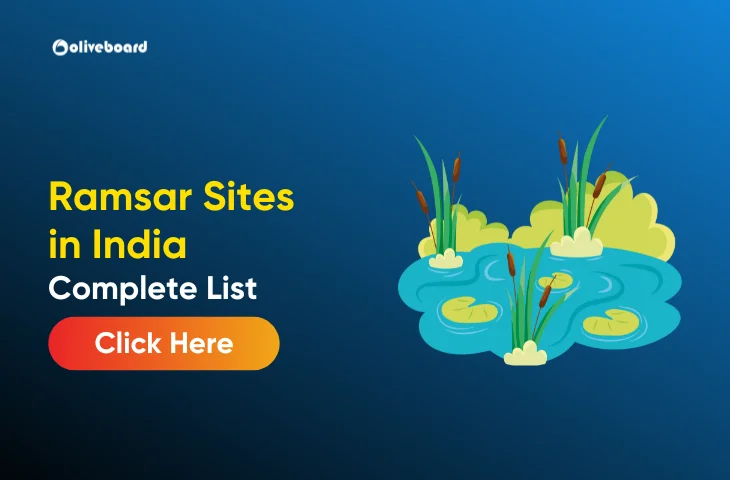Ramsar Sites in India
Ramsar sites in India are an important topic to be covered under the Environment section for Banking, SSC, and other Government Exams. Knowing the Ramsar Wetland sites, especially the recently added sites will help you in your examination. To simplify your preparation, we have come up with this blog to give you the list and details of Ramsar sites in India.
Total Ramsar Sites in India 2024
There are currently 85 Ramsar Sites in India. This is the highest number in South Asia.
On 14th August 2024, the eve of Independence Day 2024, India increased its tally of Ramsar sites to 85 from existing 82 by designating 3 more wetlands as Ramsar Sites.
With the inclusion of these new sites, the total area of Ramsar sites in India has reached 1,358,067.757 hectares. The three newly designated Ramsar sites are Nanjarayan Bird Sanctuary and Kazhuveli Bird Sanctuary in Tamil Nadu, and Tawa Reservoir in Madhya Pradesh. This expansion reflects the Ministry of Environment, Forest, and Climate Change’s strong commitment to the conservation and management of wetlands in India. These sites highlight the ongoing efforts to preserve vital ecosystems and promote biodiversity across the country.
India is a country with rich biodiversity and is home to a large number of wetlands. Wetlands are important ecosystems that provide a range of ecological services like water purification, groundwater recharge, and habitat for diverse flora and fauna. India has designated a number of wetlands as Ramsar Sites, which are internationally recognized wetlands of ecological importance.
List of Ramsar Sites in India 2024
| S.No. | Ramsar Site | State/UT | Designated Year | Area (Hectares) |
| 1 | Kolleru Lake | Andhra Pradesh | 2002 | 90100 |
| 2 | Deepor Beel | Assam | 2002 | 4000 |
| 3 | Kabartal Wetland | Bihar | 2020 | 2620 |
| 4 | Nagi Bird Sanctuary | Bihar | 2024 | 205.8 |
| 5 | Nakti Bird Sanctuary | Bihar | 2024 | 332.6 |
| 6 | Nalsarovar | Gujarat | 2012 | 12000 |
| 7 | Wadhvana Wetland | Gujarat | 2021 | 630 |
| 8 | Thol Lake Wildlife Sanctuary | Gujarat | 2021 | 699 |
| 9 | Khijadia Wildlife Sanctuary | Gujarat | 2021 | 512 |
| 10 | Nanda Lake | Goa | 2022 | 42 |
| 11 | Sultanpur National Park | Haryana | 2021 | 143 |
| 12 | Bhindawas Wildlife Sanctuary | Haryana | 2021 | 412 |
| 13 | Pong Dam Lake | Himachal Pradesh | 2002 | 15662 |
| 14 | Chandertal Wetland | Himachal Pradesh | 2005 | 49 |
| 15 | Renuka Wetland | Himachal Pradesh | 2005 | 20 |
| 16 | Wular Lake | Jammu and Kashmir | 1990 | 18900 |
| 17 | Surinsar-Mansar Lakes | Jammu and Kashmir | 2005 | 350 |
| 18 | Hokera Wetland | Jammu and Kashmir | 2005 | 1375 |
| 19 | Hygam Wetland Conservation Reserve | Jammu and Kashmir | 2022 | 802 |
| 20 | Shallbugh Wetland Conservation Reserve | Jammu and Kashmir | 2022 | 1675 |
| 21 | Ranganathittu Bird Sanctuary | Karnataka | 2022 | 518 |
| 22 | Ankasamudra Bird Conservation Reserve | Karnataka | 2023 | 98.76 |
| 23 | Aghanashini Estuary | Karnataka | 2023 | 4801 |
| 24 | Magadi Kere Conservation Reserve | Karnataka | 2023 | 54.38 |
| 25 | Asthamudi Wetland | Kerala | 2002 | 6140 |
| 26 | Sasthamkotta Lake | Kerala | 2002 | 373 |
| 27 | VembanadKol Wetland | Kerala | 2002 | 151250 |
| 28 | Tso Kar Wetland Complex | Ladakh | 2020 | 9577 |
| 29 | Tsomoriri Lake | Ladakh | 2002 | 12000 |
| 30 | Bhoj Wetlands | Madhya Pradesh | 2002 | 3201 |
| 31 | Sirpur Wetland | Madhya Pradesh | 2022 | 161 |
| 32 | Sakhya Sagar | Madhya Pradesh | 2022 | 248 |
| 33 | Yashwant Sagar | Madhya Pradesh | 2022 | 823 |
| 34 | Tawa Reservoir | Madhya Pradesh | 2024 | 20050 |
| 35 | Nandur Madhameshwar | Maharashtra | 2019 | 1437 |
| 36 | Lonar Lake | Maharashtra | 2020 | 427 |
| 37 | Thane Creek | Maharashtra | 2022 | 6521 |
| 38 | Loktak Lake | Manipur | 1990 | 26600 |
| 39 | Pala Wetland | Mizoram | 2021 | 1850 |
| 40 | Chilka Lake | Odisha | 1981 | 116500 |
| 41 | Bhitarkanika Mangroves | Odisha | 2002 | 65000 |
| 42 | Satkosia Gorge | Odisha | 2021 | 98197 |
| 43 | Tampara Lake | Odisha | 2021 | 300 |
| 44 | Hirakud Reservoir | Odisha | 2021 | 65400 |
| 45 | Ansupa Lake | Odisha | 2021 | 231 |
| 46 | Harike Lake | Punjab | 1990 | 4100 |
| 47 | Kanjli Lake | Punjab | 2002 | 183 |
| 48 | Ropar Lake | Punjab | 2002 | 1365 |
| 49 | Beas Conservation Reserve | Punjab | 2019 | 6429 |
| 50 | Keshopur – Miani Community Reserve | Punjab | 2019 | 344 |
| 51 | Nangal Wildlife Sanctuary | Punjab | 2019 | 116 |
| 52 | Keoladeo Ghana National Park | Rajasthan | 1981 | 2873 |
| 53 | Sambhar Lake | Rajasthan | 1990 | 24000 |
| 54 | Point Calimere Wildlife and Bird Sanctuary | Tamil Nadu | 2002 | 38500 |
| 55 | Koonthankulam Bird Sanctuary | Tamil Nadu | 2021 | 72 |
| 56 | Chitrangudi Bird Sanctuary | Tamil Nadu | 2021 | 260 |
| 57 | Karikili Bird Sanctuary | Tamil Nadu | 2022 | 58 |
| 58 | Pichavaram Mangrove | Tamil Nadu | 2022 | 1479 |
| 59 | Pallikaranai Marsh Reserve Forest | Tamil Nadu | 2022 | 1248 |
| 60 | Gulf of Mannar Marine Biosphere Reserve | Tamil Nadu | 2022 | 52672 |
| 61 | Vembannur Wetland Complex | Tamil Nadu | 2022 | 20 |
| 62 | Vellode Bird Sanctuary | Tamil Nadu | 2022 | 77 |
| 63 | Udhayamarthandapuram Bird Sanctuary | Tamil Nadu | 2022 | 44 |
| 64 | Vedanthangal Bird Sanctuary | Tamil Nadu | 2022 | 40 |
| 65 | Suchindram Theroor Wetland Complex | Tamil Nadu | 2022 | 94 |
| 66 | Vaduvur Bird Sanctuary | Tamil Nadu | 2022 | 113 |
| 67 | Kanjirankulam Bird Sanctuary | Tamil Nadu | 2022 | 97 |
| 68 | Karaivetti Bird Sanctuary | Tamil Nadu | 2023 | 453.72 |
| 69 | Longwood Shola Reserve Forest | Tamil Nadu | 2023 | 116.007 |
| 70 | Nanjarayan Bird Sanctuary | Tamil Nadu | 2024 | 125.865 |
| 71 | Kazhuveli Bird Sanctuary | Tamil Nadu | 2024 | 5151.6 |
| 72 | Rudrasagar Lake | Tripura | 2005 | 240 |
| 73 | Upper Ganga River | Uttar Pradesh | 2005 | 26590 |
| 74 | Nawabganj Bird Sanctuary | Uttar Pradesh | 2019 | 225 |
| 75 | Parvati Arga Bird Sanctuary | Uttar Pradesh | 2019 | 722 |
| 76 | Saman Bird Sanctuary | Uttar Pradesh | 2019 | 526 |
| 77 | Samaspur Bird Sanctuary | Uttar Pradesh | 2019 | 799 |
| 78 | Sandi Bird Sanctuary | Uttar Pradesh | 2019 | 309 |
| 79 | Sarsai NawarJheel | Uttar Pradesh | 2019 | 161 |
| 80 | Sur Sarovar | Uttar Pradesh | 2020 | 431 |
| 81 | Haiderpur Wetland | Uttar Pradesh | 2021 | 6908 |
| 82 | Bakhira Wildlife Sanctuary | Uttar Pradesh | 2021 | 2894 |
| 83 | Asan Conservation Reserve | Uttarakhand | 2020 | 444 |
| 84 | East Calcutta Wetlands | West Bengal | 2002 | 12500 |
| 85 | Sunderbans Wetland | West Bengal | 2019 | 423000 |
State-wise Ramsar sites in India 2024
Here is a table showing the Ramsar Sites in India organized by state/UT:
| S.No. | State/UT | No. of Ramsar Sites | Name of Ramsar Sites Present |
| 1 | Andhra Pradesh | 1 | Kolleru Lake |
| 2 | Assam | 1 | Deepor Beel |
| 3 | Bihar | 3 | Kabartal Wetland, Nagi Bird Sanctuary, Nakti Bird Sanctuary |
| 4 | Gujarat | 4 | Nalsarovar, Wadhvana Wetland, Thol Lake Wildlife Sanctuary, Khijadia Wildlife Sanctuary |
| 5 | Goa | 1 | Nanda Lake |
| 6 | Haryana | 2 | Sultanpur National Park, Bhindawas Wildlife Sanctuary |
| 7 | Himachal Pradesh | 3 | Pong Dam Lake, Chandertal Wetland, Renuka Wetland |
| 8 | Jammu and Kashmir | 5 | Wular Lake, Surinsar-Mansar Lakes, Hokera Wetland, Hygam Wetland Conservation Reserve, Shallbugh Wetland Conservation Reserve |
| 9 | Karnataka | 4 | Ranganathittu Bird Sanctuary, Ankasamudra Bird Conservation Reserve, Aghanashini Estuary, Magadi Kere Conservation Reserve |
| 10 | Kerala | 3 | Asthamudi Wetland, Sasthamkotta Lake, VembanadKol Wetland |
| 11 | Ladakh | 2 | Tso Kar Wetland Complex, Tsomoriri Lake |
| 12 | Madhya Pradesh | 5 | Bhoj Wetlands, Sirpur Wetland, Sakhya Sagar, Yashwant Sagar, Tawa Reservoir |
| 13 | Maharashtra | 3 | Nandur Madhameshwar, Lonar Lake, Thane Creek |
| 14 | Manipur | 1 | Loktak Lake |
| 15 | Mizoram | 1 | Pala Wetland |
| 16 | Odisha | 6 | Chilka Lake, Bhitarkanika Mangroves, Satkosia Gorge, Tampara Lake, Hirakud Reservoir, Ansupa Lake |
| 17 | Punjab | 6 | Harike Lake, Kanjli Lake, Ropar Lake, Beas Conservation Reserve, Keshopur – Miani Community Reserve, Nangal Wildlife Sanctuary |
| 18 | Rajasthan | 2 | Keoladeo Ghana National Park, Sambhar Lake |
| 19 | Tamil Nadu | 18 | Point Calimere Wildlife and Bird Sanctuary, Koonthankulam Bird Sanctuary, Chitrangudi Bird Sanctuary, Karikili Bird Sanctuary, Pichavaram Mangrove, Pallikaranai Marsh Reserve Forest, Gulf of Mannar Marine Biosphere Reserve, Vembannur Wetland Complex, Vellode Bird Sanctuary, Udhayamarthandapuram Bird Sanctuary, Vedanthangal Bird Sanctuary, Suchindram Theroor Wetland Complex, Vaduvur Bird Sanctuary, Kanjirankulam Bird Sanctuary, Karaivetti Bird Sanctuary, Longwood Shola Reserve Forest, Nanjarayan Bird Sanctuary, Kazhuveli Bird Sanctuary |
| 20 | Tripura | 1 | Rudrasagar Lake |
| 21 | Uttar Pradesh | 10 | Upper Ganga River, Nawabganj Bird Sanctuary, Parvati Arga Bird Sanctuary, Saman Bird Sanctuary, Samaspur Bird Sanctuary, Sandi Bird Sanctuary, Sarsai NawarJheel, Sur Sarovar, Haiderpur Wetland, Bakhira Wildlife Sanctuary |
| 22 | Uttarakhand | 1 | Asan Conservation Reserve |
| 23 | West Bengal | 2 | East Calcutta Wetlands, Sunderbans Wetland |
First Ramsar site in India
India has two co-first Ramsar Sites, both designated in 1981:
- Chilika Lake in Odisha: This brackish lake is the largest coastal lagoon in India and a wintering ground for migratory birds.
- Keoladeo National Park in Rajasthan: Previously known as the Bharatpur Bird Sanctuary, this park is famous for its rich birdlife, especially resident and migratory waterfowl.
The first Ramsar sites in India were Chilika Lake (Odisha) and Keoladeo National Park (Rajasthan).
New Ramsar site in India
On the eve of Independence Day 2024, Union Minister for Environment, Forest, and Climate Change, Shri Bhupender Yadav, announced that India has increased its number of Ramsar sites, or Wetlands of International Importance, to 85 by designating three additional wetlands. The newly included sites are Nanjarayan Bird Sanctuary and Kazhuveli Bird Sanctuary in Tamil Nadu, and Tawa Reservoir in Madhya Pradesh. This expansion reflects India’s ongoing efforts to conserve and manage its valuable wetland ecosystems.
Before that, on 5th June 2024, India designated two new Ramsar sites on World Environment Day.
- Nagi Bird Sanctuary (Bihar)
- Nakti Bird Sanctuary (Bihar)
India celebrated World Environment Day by designating Nagi and Nakti bird sanctuaries as its newest wetlands of international importance under the Ramsar Convention. These man-made reservoirs are located in the Jhajha forest range of Jamui district in Bihar. With this addition, the total number of Ramsar-recognized wetlands in India had then reached 82.
Smallest Ramsar site in India – Renuka Wetland, Himachal Pradesh
The smallest Ramsar site in India is the Renuka Wetland, located in Himachal Pradesh. It covers an area of only 20 hectares (0.2 square kilometers). This wetland was designated a Ramsar site in 2012. It’s a natural wetland fed by freshwater springs and features an inland subterranean karst formation.
Largest Ramsar site in India – Sunderbans Wetland, West Bengal
The Sunderbans Wetland in West Bengal is the largest Ramsar site in India with an area of 423,000 hectares. It was designated as a Ramsar site on 30-01-2019.
Most Ramsar Sites in which State? – Tamil Nadu
The state with the most Ramsar sites in India is Tamil Nadu, with 18 Ramsar sites:
- Point Calimere Wildlife and Bird Sanctuary
- Koonthankulam Bird Sanctuary
- Chitrangudi Bird Sanctuary
- Karikili Bird Sanctuary
- Pichavaram Mangrove
- Pallikaranai Marsh Reserve Forest
- Gulf of Mannar Marine Biosphere Reserve
- Vembannur Wetland Complex
- Vellode Bird Sanctuary
- Udhayamarthandapuram Bird Sanctuary
- Vedanthangal Bird Sanctuary
- Suchindram Theroor Wetland Complex
- Vaduvur Bird Sanctuary
- Kanjirankulam Bird Sanctuary
- Karaivetti Bird Sanctuary
- Longwood Shola Reserve Forest
- Nanjarayan Bird Sanctuary
- Kazhuveli Bird Sanctuary
What is a Ramsar site?
A Ramsar site is a wetland site designated to be of international importance under the Ramsar Convention, an international environmental treaty established by UNESCO in 1971. The treaty’s goal is the conservation and wise use of wetlands.
What is the Ramsar Convention?
The Ramsar Convention, also known as the Convention on Wetlands, is an international treaty adopted on 2nd February 1971 in the Iranian city of Ramsar, on the southern shore of the Caspian Sea. It’s the first of its kind focusing on conserving natural resources, specifically wetlands.
It came into force on 1st February 1982 in India, under which wetlands of international importance are declared as Ramsar sites.
Here’s a breakdown of the Ramsar Convention’s key aspects:
- Goal: Promote the conservation and wise use of wetlands and their resources.
- Scope:
- Covers a wide variety of wetlands including marshes, swamps, bogs, lakes, rivers, and estuaries.
- Almost 90% of UN member states are Contracting Parties, meaning they’re committed to the Convention’s goals.
- Actions:
- Encourages designation of Ramsar sites – wetlands deemed internationally important.
- Promotes international cooperation on wetland conservation issues.
- Emphasizes wise use, meaning sustainable practices that benefit both humans and the environment.
World Wetlands Day, celebrated annually on February 2nd, commemorates the signing of the Ramsar Convention on Wetlands in 1971. The day aims to raise global awareness about the importance of wetlands for human well-being and the environment. The official theme for World Wetlands Day 2024 was “Wetlands and Human Wellbeing”.
What is a Wetland?
A wetland is a distinct ecosystem that is flooded or saturated by water, either permanently for years or decades or seasonally for shorter periods. Flooding results in oxygen-poor processes taking place, especially in the soils. Wetlands are considered among the most biologically diverse of all ecosystems, serving as home to a wide range of plant and animal species.
Facts About Ramsar Sites in the World 2024
Today, the Ramsar List is the world’s largest network of protected areas. There are over 2,500 Ramsar Sites on the territories of 172 Convention Contracting Parties across the world, covering more than 2.57 million square kilometers.
The network of Ramsar Sites is truly global and includes coastal and inland wetlands of all types in all six Convention on Wetlands regions.
- The world’s first Site was the Cobourg Peninsula in Australia, designated in 1974.
- The largest Sites are Rio Negro in Brazil (120,000 square kilometers), Ngiri-Tumba-Maindombe in the Democratic Republic of Congo, and Queen Maud Gulf in Canada; these Sites each cover over 60,000 square km.
- The countries with the most Sites are the United Kingdom with 175 and Mexico with 144.
- Bolivia has the largest area with 148,000 square km under the Convention protection; Canada, Chad, Congo and the Russian Federation have also each designated over 100,000 square km.
This is the complete updated Ramsar sites in India list. Download the Oliveboard App for the latest updates on Banking and Government Exams.
- Indian Bank Recruitment 2025 Out for 1500 Apprentice Posts
- Indian Bank Apprentice Salary 2025, Pay Scale, Salary Structure
- Indian Bank Apprentice Syllabus & Exam Pattern 2025, Check Details
- Railway RPF Syllabus 2024, Check Exam Pattern, Topic And Syllabus
- SSC JE vs RRB JE, Which Is Better? Know Detailed Comparison
- SSC CGL Study Plan 2025 For Next 25 Days With Tips, Tricks
Ramsar Sites in India 2024 – FAQs
Ans. There are a total of 85 Ramsar sites in India as of August 2024.
Ans. The Sunderbans Wetland in West Bengal is the largest Ramsar site in India with an area of 423,000 hectares.
Ans. The smallest Ramsar site in India is the Renuka Wetland, located in Himachal Pradesh covering an area of only 20 hectares.
Ans. The countries with the most Ramsar Sites are the United Kingdom (175) and Mexico (144), as per the Ramsar List.
Ans. Any wetland site which has been listed under the Ramsar Convention 1971, that aims to conserve it and promote sustainable use of its natural resources.
Ans. The Ramsar Convention on Wetlands defines wetlands as “areas of marsh, fen, peat land or water, whether natural or artificial, permanent or temporary, with water that is static or flowing, fresh, brackish or salt, including areas of marine water the depth of which at low tide does not exceed six meters.”

Hello, I’m Aditi, the creative mind behind the words at Oliveboard. As a content writer specializing in state-level exams, my mission is to unravel the complexities of exam information, ensuring aspiring candidates find clarity and confidence. Having walked the path of an aspirant myself, I bring a unique perspective to my work, crafting accessible content on Exam Notifications, Admit Cards, and Results.
At Oliveboard, I play a crucial role in empowering candidates throughout their exam journey. My dedication lies in making the seemingly daunting process not only understandable but also rewarding. Join me as I break down barriers in exam preparation, providing timely insights and valuable resources. Let’s navigate the path to success together, one well-informed step at a time.






